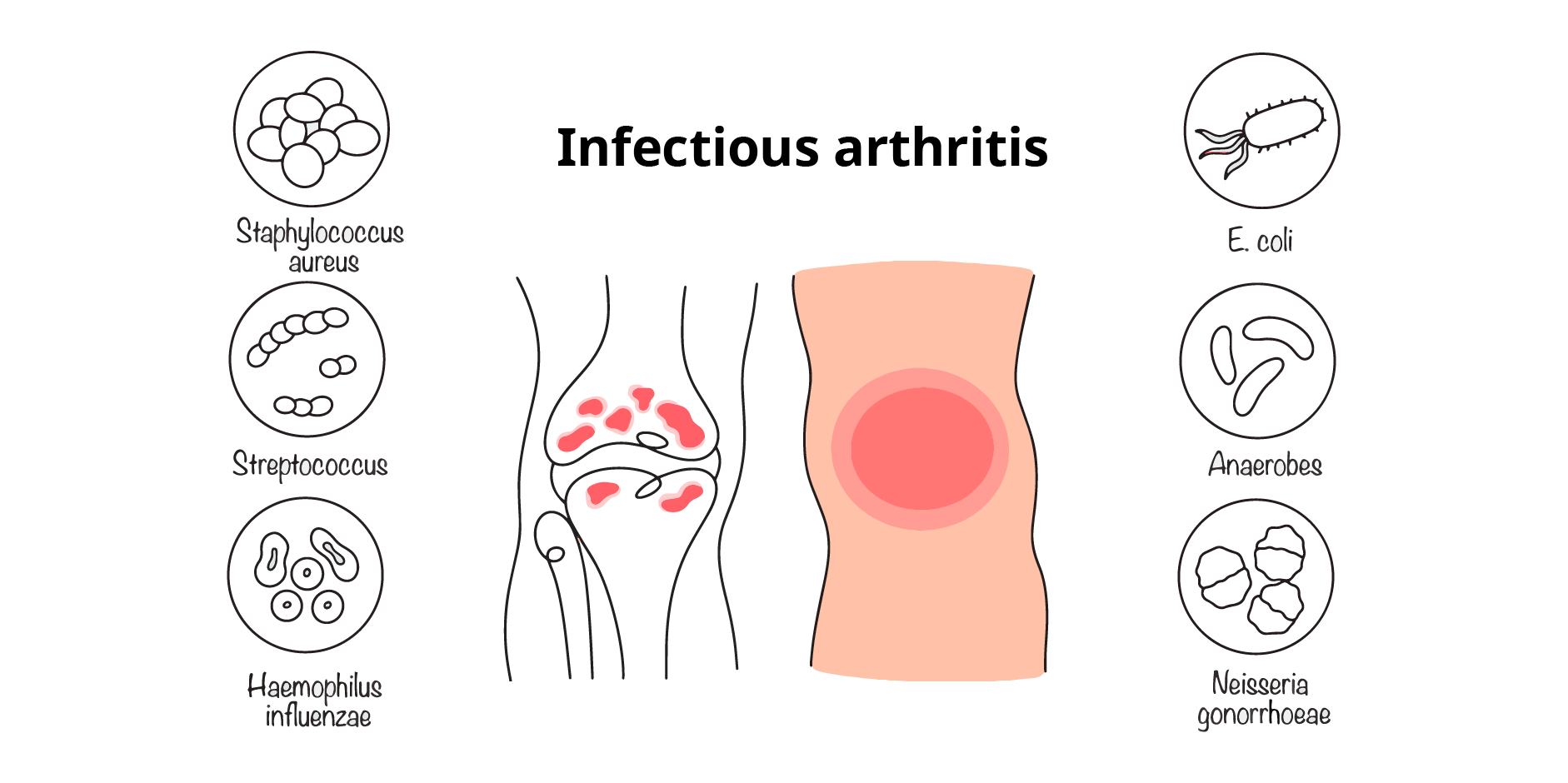Content on this page:
Content on this page:
Introduction
Infectious arthritis is a destructive form of joint disease caused by hematogenous spread of organisms from a distant site of infection or a direct penetration of the joint as a result of trauma, surgery or spread from adjacent osteomyelitis. This may also be called septic arthritis, bacterial arthritis, or pyogenic arthritis.
Epidemiology
The prevalence of infectious arthritis varies with age, ethnicity and socioeconomic status. The annual incidence rate varies from 1 to 35 cases per 100,000 individuals in different countries. There is a higher incidence in children than adults. The incidence of the large joint is higher than small joints and increases with age. Males are more likely affected than females. In Asia, particularly in Thailand, the prevalence and incidence increase with age, mainly among those ≥ 60 years of age.
Etiology
Pathogens Causing Infectious Arthritis
 Infectious Arthritis_Disease Background
Infectious Arthritis_Disease BackgroundStaphylococcus aureus
Staphylococcus aureus is the most common pathogen in infectious arthritis of both native and prosthetic joints. Infections caused by methicillin-resistant S aureus (MRSA) are usually more aggressive, with involvement of >1 joint. MRSA is common in intravenous (IV) drug users, elderly and orthopedic-associated infections.
Staphylococcus epidermidis
Staphylococcus epidermidis infection is more common in prosthetic joint infection.
Streptococci
Streptococci are the most common Gram-positive aerobes causing infectious arthritis next to S aureus. These are important infectious arthritis pathogens in patients with serious infections of the genitourinary or gastrointestinal tract. Group B streptococci are a common cause of infectious arthritis in neonates while Streptococcus pyogenes and Streptococcus pneumoniae are common pathogens in children ≤5 years old who have infectious arthritis.
Gram-negative Bacilli
Gram-negative bacilli are common etiologic agents of infectious arthritis in neonates, IV drug users, elderly and immunocompromised persons. Elderly patients frequently have underlying joint diseases and concomitant diseases like diabetes mellitus (DM) and rheumatoid arthritis. Disease-modifying drugs used to treat rheumatoid arthritis (eg Infliximab and Etanercept) may predispose patients to the development of infectious arthritis. Haemophilus influenzae was formerly a common pathogen in infectious arthritis in children aged 1 month-5 years, but widespread vaccination against the organism has drastically reduced the number of cases. Kingella kingae is the most common cause of bacterial arthritis in children younger than 2-3 years old. P aeruginosa may be a cause of infectious arthritis in IV drug users, premature infants, and patients with central vascular catheters.
Neisseria gonorrhoeae
Neisseria gonorrhoeae is a possible etiologic agent in young, healthy, sexually active adults with infectious arthritis. Its incidence is frequently related to the socioeconomic status.
Anaerobes
Anaerobic infections are more common in patients with DM and those with prosthetic joint infection.
Mycobacterial sp and Fungi
Mycobacterial sp and fungi are much less common causes of infectious arthritis compared to bacteria. Low immune system, recent travel and living in endemic areas are determinants for people susceptible to mycobacterial infections. The infectious arthritis caused by these organisms usually presents with marked joint swelling, mild signs of acute inflammation and few systemic symptoms. Tuberculous infectious arthritis may be more common in low-income groups while other mycobacterial species can cause infectious arthritis in HIV-infected persons. Candida arthritis is more common in immunocompromised individuals and is associated with the presence of a central vascular catheter.
Pathophysiology
Hematogenous spread is the most common route for infections to reach the joint space, with penetrating trauma or inoculation as potential triggers. The pathogenic bacteria enter the joints, resulting in leukocyte infiltration and serous exudation. As the synovitis worsens, there is increased vascular permeability and fibrin deposition that cause articular damage leading to poor joint function. Further worsening of the inflammation causes purulent conversion of the exudate, articular cartilage involvement (destruction of the subchondral bone), and cellulitis in the surrounding soft tissue.
Risk Factors
The risk factors in the development of infectious arthritis are newborns and adults >80 years old; recent joint surgery, prosthetic joints, arthroscopy, osteoarthritis, rheumatoid arthritis in a specific joint, direct joint injury, open reduction of fracture and intra-articular steroid injection; systemic diseases (eg rheumatoid arthritis, DM, malignancies); the use of glucocorticoids and other immunosuppressive drugs; extra-articular site of infection that may have given rise to bacteremic seeding in a joint (eg pyelonephritis, pneumonia and skin infection); alcoholism and IV drug abuse; and low socioeconomic status.
